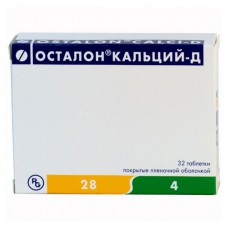Expiration date: 01/2025
The composition and form of issue:
A set of pills of 2 types
Tablets, film-coated. 1 tablet contains active substances:
colecalciferol powder 4 mg
(in terms of colecalciferol 0.01 mg, which corresponds to 400 IU of vitamin D3)
calcium carbonate powder 1578 mg
(equivalent to 1500 mg of calcium carbonate in terms of calcium 600 mg)
excipients: d,l-&alpha-tocopherol soybean oil hydrogenated gelatin sucrose corn starch maltodextrin Polysorbate 80 MCC copovidone crospovidone magnesium stearate
film cover: sepifilm 4202 yellow (hypromellose, macrogol, talc, titanium dioxide (E171), dye iron oxide yellow (E172)
Tablets, film-coated 1 tablet contains active substance:
alendronate sodium trihydrate 91,35 mg
(equivalent to 70 mg of Alendronic acid)
excipients: microcrystalline cellulose silica colloidal anhydrous croscarmellose sodium magnesium stearate
film cover: Chandelier Clear LS 103 (MCC, carrageenan, macrogol)
Pills colecalciferol+calcium carbonate: in blisters of PVC/al for 14 PCs.
Tablets alendronate sodium in blister al/al 4 PCs.
A set of pills: in the paper cartons 2 blister tablets colecalciferol+calcium carbonate and 1 blister of tablets alendronate sodium or 6 blisters pill colecalciferol+calcium carbonate and 3 blisters of tablets alendronate sodium.
Description pharmaceutical form:
Pills colecalciferol+calcium carbonate: oblong, film-coated pale brownish-yellow with line on one side in the cross-section - white.
Tablets alendronate sodium: round biconvex shaped, film-coated white color, with engraving "M14" on one side.
Pharmacokinetics:
Alendronic acid. Bioavailability when taken on an empty stomach 2 HR before meals and 0.64% (women) and 0.6% (men) when you receive 1-1,5 hour before meals is reduced by 40%. Coffee and orange juice reduces bioavailability by 60%. Vd — 28 l (excluding the bone). When taken in therapeutic doses, the drug concentration in plasma is less than 5 ng/ml. the relationship with the squirrels — 78%. Renal clearance is 71 ml/min (at the dose 10 mg in/in). 6 hours after I/V administration, the concentration in plasma decreases by more than 95%. T1/2 — 72 h, the final T1/2 — more than 10 years (reflects withdrawal from the bone tissue). Primarily excreted by the kidney, a small amount is removed through the intestines.
Cholecalciferol. The bioavailability of colecalciferol in combination with Alendronic acid is similar to the bioavailability of cholecalciferol at the isolated reception.
Calcium carbonate. Approximately 1/5–1/3 h oral administration of the drug is absorbed in the small intestine this process depends on the presence of vitamin D, pH, diet and the factors that affect the ability to bind calcium. Absorption of calcium is increased in case of its deficiency and the use of diets with reduced calcium content. In plasma, about 45% is in complex with proteins. About 20% is excreted by the kidneys, the remainder (80%) is removed through the intestines.
Description pharmacological action:
Combination drug
Alendronic acid, as bisfosfontam penetrates into the zone of active bone resorption, inhibits the process of bone resorption, without exerting direct influence on the formation of new bone tissue leading to increased bone mass. During treatment is formed normal bone tissue (at therapeutic doses Alendronic acid does not cause osteomalacia).
Calcium carbonate contains calcium, which is an important element that plays a critical role in electrolyte balance. It is required for muscle contractions, nerve impulses and blood clotting. It plays a vital role in transferring intracellular signal in the control of various metabolic processes. Calcium is the major inorganic component of bone tissue. 99% of the total content of calcium in the body is present in bone tissue.
Cholecalciferol increases intestinal absorption of calcium and phosphate, regulates their excretion by the kidneys and regulates calcium concentration in blood plasma.
Indications:
The combination of Alendronic acid colecalciferol+calcium carbonate recommended in the treatment of osteoporosis:
- postmenopausal women (reducing the risk of fractures, including hip fractures and compression fractures of the spine)
- for men (reducing the risk of fractures)
- caused by prolonged intake of corticosteroids.
Contraindications:
Alendronic acid
- individual intolerance to the drug
- hypocalcemia
- pregnancy
- lactation
- children's age
- anomalies of the esophagus and other factors that hinder the patency of the esophagus (including achalasia, stricture)
- the inability of the patient to remain upright (standing or sitting straight) for 30 min.
- chronic renal failure (Cl creatinine <35 ml/min).
Colecalciferol+calcium carbonate
- increased individual sensitivity to product components
- hypercalcemia (including as a result of hyperparathyroidism primary or secondary)
- hypercalciuria
- calcium stones
- hypervitaminosis D
- sarcoidosis
- osteoporosis due to immobilization
- pulmonary tuberculosis (active form).
Precautions: gastrointestinal diseases in the phase of exacerbation, dysphagia, esophagitis, gastritis, gastric ulcer and duodenal ulcer.
Application of pregnancy and breast-feeding:
Ostalon Calcium-D is contraindicated in pregnancy and lactation.
Side effects:
The incidence of side effects: often (&ge1/100, <1/10) uncommon (&ge1/1000, <1/100) rare (&ge1/10000, <1 / 1000th).
Alendronic acid
By the blood: often — pain in the abdomen, dyspepsia, constipation, diarrhea, flatulence, esophageal ulcer, dysphagia, bloating, heartburn infrequently — nausea, vomiting, gastritis, esophagitis, erosion of the esophagus, melena rare — narrowing of the esophagus, oropharyngeal ulcer, perforation, upper gastrointestinal ulcer, bleeding, however, the relationship with treatment is not always straightforward.
From the side of musculoskeletal system: often — ossalgia, arthralgia, myalgia.
From the nervous system: often — headache, irritability.
With the skin: rarely — itching, rash, hyperemia of skin.
General: rarely, allergic reactions (urticaria, angioedema, Stevens-Johnson syndrome, toxic epidermal necrolysis), transient symptoms, which often appear at the beginning of treatment (myalgia, weakness, malaise, in rare cases, fever), rash, photosensitivity, asymptomatic hypocalcemia (often accompanied by predisposing factors) and hypophosphatemia.
In the treatment of bisphosphonates have described the development of osteonecrosis of the maxilla and mandible in patients with cancer against the backdrop of anticancer treatment.
On the part of the organ of vision: rarely uveitis, scleritis.
Laboratory parameters: rare — transient, weakly expressed in asymptomatic hypocalcemia and hypophosphatemia.
Colecalciferol+calcium carbonate
Metabolism and impaired nutrient absorption: rarely — hypercalcemia and hypercalciuria.
Gastrointestinal: rarely — constipation, flatulence, nausea, abdominal pain, diarrhea.
From the skin: rarely — itching, rash, hives.
Drug interactions:
Simultaneous use of calcium, antacids, or other drugs reduces the absorption of Alendronic acid. The interval between doses of drugs should be not less than 1 h.
Ranitidine increases the bioavailability of Alendronic acid in 2% (clinical significance not determined).
NPVS increase the side effects of Alendronic acid from the blood.
Thiazide diuretics reduce the excretion of calcium. Because of the increased risk of hypercalcaemia the calcium content of the serum should be regularly monitored throughout the course of treatment thiazide diuretics.
Corticosteroids reduce calcium absorption. During the course of treatment with glucocorticoids may need to increase dose combinations colecalciferol+calcium carbonate.
Concurrent use with ion-exchange resins of the type cholestyramine or laxatives may reduce absorption of vitamin D.
Application of a combination of colecalciferol+calcium carbonate with tetracycline or perhaps 2 hours before taking tetracycline, or 4-6 hours after.
Combination colecalciferol+calcium carbonate may enhance the toxicity of cardiac glycosides. Patients need to conduct a study of the concentration of calcium, ECG.
When concomitant administration of sodium fluoride and combinations colecalciferol+calcium carbonate, the interval between doses of drugs should be at least 3 hours.
Oxalic acid prevents the absorption of calcium, because it forms insoluble complexes with calcium ions. The patient should not take the combination colecalciferol+calcium carbonate for 2 hours after ingestion of foods with a high content of oxalic acid (rhubarb, spinach).
Method of application and dose:
Inside.
Alendronic acid. 1 table. 1 time a week. Pill entirely, in the morning on an empty stomach with a large glass of water at least 30 minutes before the first food, drinking of beverages or other drugs.
The drug should be taken on the same day of the week.
Drink only plain water, as other beverages (including mineral water, coffee, tea, orange juice) reduce the absorption.
After ingestion, the patient should maintain a vertical body position (standing or sitting) for at least 30 minutes. do Not take the drug at bedtime or before the morning rising from bed.
You should warn the patient that in the case of missing a regular dose of Alendronic acid missed tablet should be taken on the next day. In any case, you should not take two tablets on the same day.
The tablet cannot be chewed or sucked.
Colecalciferol+calcium carbonate. 1 table. daily, after lunch or dinner with a large glass of water. A pill not to chew. On the day of reception Alendronic acid, the drug should be taken no earlier than 3 h after administration of Alendronic acid.
Overdose:
Alendronic acid
Symptoms: hypocalcemia, hypophosphatemia, as well as adverse reactions from the gastrointestinal tract — diarrhea, heartburn, esophagitis, gastritis, or erosive-ulcerative lesions of the gastrointestinal tract.
Treatment: milk or calcium-containing antacids to bind the drug.
Due to the risk of esophageal irritation, should not cause vomiting, the patient should be given a vertical position (standing or sitting).
Colecalciferol+calcium carbonate
Symptoms: hypercalcemia (anorexia, thirst, nausea, vomiting, constipation, pain in the abdomen, muscle weakness, fatigue, polyuria, bone pain, hypercreatininemia, hypercalciuria, arrhythmia) and hypervitaminosis D prolonged use — calcification of vessels and tissues.
Treatment: at the onset of overdose symptoms should seek medical attention.
Precautions:
Alendronic acid
To reduce the irritating effect on the esophagus must be taken immediately as you Wake up, drinking a full glass of water after taking should not lie down for 30 minutes (dangerous to use in the event of failure of the patient to stand or sit upright for 30 minutes). Taking at bedtime or in a horizontal position increases the risk of developing esophagitis.
In patients with hypocalcemia before treatment Alendronic acid is necessary to conduct corrective therapy of disorders of mineral metabolism, including vitamin D deficiency, and hypoparathyroidism.
In the treatment process due to the positive effects of Alendronic acid on the mineral density of bone tissue may be insignificant asymptomatic decrease in the concentration of calcium and phosphate in serum.
When taking bisphosphonates (especially in concomitant therapy corticosteroids) is necessary to ensure an adequate intake of calcium and vitamin D from food or drugs.
There are reports of osteonecrosis of the jaw generally associated with tooth extraction and/or local infection (including osteomyelitis) in cancer patients treated with bisphosphonates, mostly in a/V. Many of these patients also received chemotherapy and corticosteroids. There are also reports of osteonecrosis of the jaw in patients with osteoporosis receiving oral bisphosphonates.
Before the appointment of therapy of bisphosphonates for patients with concomitant risk factors (e.g. cancer, chemotherapy, radiation therapy, intake of corticosteroids, inadequate oral hygiene) must undergo a dental examination with appropriate preventive dentistry.
Patients undergoing treatment bisphosphonates should avoid invasive dental procedures. Patients developed osteonecrosis of the jaw, located on the bisphosphonates treatment, dental surgical intervention may lead to worsening of the condition. If necessary, surgical interventions should be considered that the data on the possibility of reducing the risk of developing osteonecrosis of the jaw after the abolition of bisphosphonate do not exist.
Colecalciferol+calcium carbonate
In order to avoid the overdose it is necessary to take into account the additional intake of vitamin D from other sources.
The intake of foods containing oxalates (sorrel, spinach) and phytin (cereals), reduces calcium absorption, so should not take colecalciferol+calcium carbonate for 2 hours after ingestion of sorrel, spinach, cereals.
Effects on ability to drive or to perform work requiring high speed physical and mental reactions. About the adverse effect of drugs on ability to drive and other activities that require concentration and speed of psychomotor reactions have not been reported.


